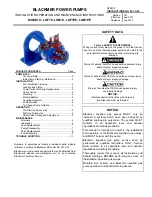
9
Power-Flo Pumps & Systems • 877-24PUMPS • www.powerflopumps.com
Pressure Test (If oil has been drained)
Remove pipe plug (18) from housing
(10). Apply pipe sealant to pressure
gauge assembly and tighten into hole.
Pressurize motor housing to 10 P.S.I. Use
soap solution around the sealed areas and
inspect joints for “air bubbles”.
If, after five minutes, the pressure is still
holding constant, and no “bubbles” are
observed, slowly bleed the pressure and
remove the gauge assembly. Replace
oil. Leek must be located and repaired if
pressure does not hold.
Pressure Test (If oil has NOT been
drained) -
Oil should be at normal level.
Remove pipe plug (18) from housing (10).
Apply pipe sealant to pressure gauge
assembly and tighten into hole. Pressurize
motor housing to 10 P.S.I. Use soap
solution around the sealed areas above
the oil level and inspect joints for “air
bubbles”. For sealed areas below oil level,
leeks will seep oil. If, after five minutes,
the pressure is still holding constant, and
no “bubbles” /oil seepage is observed,
slowly bleed the pressure and remove the
gauge assembly. Replace oil. Leek must be
located and repaired if pressure does not
hold.
Pressure builds up extremely
fast, increase pressure by
“TAPPING” air nozzle. Too much
pressure will damage seal.
DO
NOT exceed 10 P.S.I.
Oil Replacement
- Set unit upright and
refill with new cooling oil as per table
below . Fill to just above motor, but below
capacitor as an air space must remain in
the top of the housing to compensate
for oil expansion. Apply pipe thread
compound to threads of pipe plug (18)
then assemble to housing (10).
DO NOT
overfill oil. Overfilling
of housing with oil can create
excessive and dangerous hydraulic
pressure which can destroy the
pump and create a hazard.
Overfilling oil voids warranty.
Cooling Oil
Recommended Supplier/Grade
1/2 & 3/4HP - 67.6 oz
1HP - 74.4 oz
BP
Enerpar SE100
Conoco
Pale Paraffin 22
Mobile
D.T.E. Oil Light
Shell Canada
Transformer-10
Texaco
Diala-Oil-AX
Disassembly
Impeller and Volute:
1. Disconnect power.
2. Remove capscrews (20) and
lockwashers (21), vertically lift motor
housing and seal plate assembly from
volute (1). Clean out volute if necessary.
3. Inspect gasket (6) and replace if cut or
damaged.
4. Clean and examine impeller (2), for
cracks or breakage and replace if required.
To remove impeller (2), place a flat
screwdriver in the slot of the end of the
shaft to hold the shaft stationary while
unscrewing the impeller (2).
5. Remove washer (3) and v-gasket (4) and
remove if damaged.
Motor & Capacitor:
6. Posistion unit upright using blocks or
4” piece of pvc pipe, to avoid resting unit
on shaft.
7. Remove capscrews (16) and lockwahers
(17). Remove power cord (22) from motor
housing by pulling straight up in a rocking
motion.
8. Remove retaining ring (14) with a
medium flat tip screwdriver. Using a
1/4-20 bolt, screw it into the center of
the terminal block. Pull straight up in
a rocking motion. Disconnect all wires
noting where each is connected. There is a
number next to each pin for reference on
the bottom of the block.
9. Remove screws (7) and lift motor
housing (10) from seal plate (8).
10. Remove o-ring (9), replace if damaged.
11. Remove motor bolts (27), lift motor
stator assembly (29), (30) and motor end
cap (26) from seal plate (8).
12. On Single Phase units only. Check
motor capacitor (23) with an Ohm
meter by first grounding the capacitor
by placing a screwdriver across both
terminals and then removing screwdriver.
Connect Ohm meter (set on high scale) to
terminals. If needle moves to infinity (
∞
)
then drifts back, the capacitor is good. If
needle does not move or moves to infinity
(
∞
) and does not drift back, replace
capacitor (23).
13. Inspect motor winding for shorts and
check resistance values. Check rotor for
wear. If rotor or the stator windings are
defective, the complete motor must be
replaced.
Figure 2
Service
PFSE .05, .75 & 1HP
Sewage Pumps


































